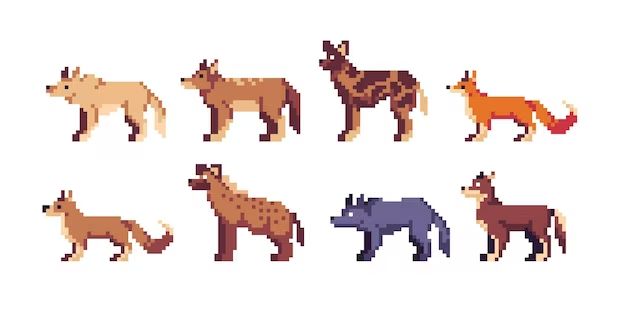Introduction
Dogs are one of the most popular pets around the world. They come in many different breeds and sizes but all belong to the same species Canis familiaris. This article will examine whether dogs should be classified as canines, which is a specific family of mammals that includes wolves, foxes, jackals, and coyotes, or if they are simply mammals like other pets such as cats. We’ll look at the biological and anatomical similarities and differences between dogs and other canines and mammals to determine if “dog” and “canine” are synonymous terms or if Canis familiaris deserves its own unique classification.
Definition of a Dog
Zoologically, dogs belong to the taxonomic family Canidae and are classified as canines. They are domesticated carnivorous mammals that are closely related to wolves, foxes, coyotes, dingoes, and jackals. The scientific name for the domestic dog is Canis lupus familiaris.
Dogs are thought to have diverged from an extinct wolf-like ancestor between 15,000 and 40,000 years ago through the process of domestication. Selective breeding by humans over thousands of years has resulted in dogs being remarkably diverse in size, physical appearance, and behavior compared to wild canines. There are over 300 recognized dog breeds today that vary extensively in looks, temperament, and abilities.
Despite their vast diversity across breeds, all dogs share key biological, genetic, and behavioral qualities that distinguish them from other mammal groups and classify them under the canine family. Their most defining features include a highly developed sense of smell, non-retractable claws, specialized teeth for shearing meat, keen hearing and vision, an athletic build for pursuing prey, and complex social behaviors.
Dogs are Canines
Dogs belong to the taxonomic family Canidae which encompasses all canine species, including wolves, foxes, jackals, and domestic dogs. The Canidae family is a part of the order Carnivora. There are over 35 extant species within the Canidae family, all of which share similar characteristics.

Some of the defining features of canines include:
- Pointed, erect ears
- Long muzzles and jaws
- Sharp, non-retractable claws
- Long legs adapted for running
- Powerful bites using 42 teeth specialized for grabbing, tearing, cutting and crushing
- Excellent sense of smell
- Social pack animals
The domestic dog, Canis familiaris, shares all of these canine hallmarks. Dogs evolved from an extinct wolf species during the late Pleistocene era. While dogs today come in a wide variety of shapes and sizes due to selective breeding, they are all still considered canines at their core.
Canine Characteristics

Canines are a biological family of carnivorous mammals that includes domestic dogs, wolves, foxes, jackals, coyotes, and many other extant and extinct dog-like mammals. Here are some of the general characteristics of canines:
- Pointed, erect ears – Most canines have upright, pointed ears that can move independently to pick up sounds from different directions. This aids their strong sense of hearing.
- Long muzzle and large nose – Canines have elongated muzzles and noses compared to other mammals. Their highly sensitive nose has up to 300 million scent receptors.
- 42 teeth – The typical dental formula for canines is 3/3 incisors, 1/1 canines, 4/4 premolars, and 2/3 molars in each quadrant. They use their teeth to grip, slice, tear and chew food.
- Claws – Canines have nonretractable claws that dig into the ground for traction when running. Their dewclaws also provide balance for changing directions while chasing prey.
- Excellent eyesight – Canines have excellent vision, particularly motion vision due to a high density of rods in their retina.
- Strong jaws and bite force – The jaws of canines are capable of a powerful bite force used for hunting, defense and cutting/chewing food.
- Agile bodies – Most canines have lean, muscular bodies built for stamina, speed and agility when running down prey across long distances.
In summary, the general characteristics of canines include pointed ears, elongated muzzles, sharp teeth, claws, keen senses of smell, sight and hearing, strong jaws and agile bodies adapted for hunting and survival. These traits make them successful predators in the wild.
Other Types of Canines

Dogs belong to the taxonomic family Canidae, which includes a diverse group of canine species like wolves, foxes, coyotes, jackals, and dingoes. Here are some examples of other types of canines besides domestic dogs:
Wolves – Wolves are considered the ancestors of domestic dogs. They are larger than most dogs and live in wild packs with complex social structures. There are different subspecies of wolves like gray wolves, red wolves, and Ethiopian wolves.
Foxes – Foxes are smaller canines withpointy faces, bushy tails, and excellent hearing. There are over 30 species of foxes adapted to different environments like the Arctic fox, red fox, and fennec fox.
Coyotes – Coyotes are versatile canines native to North America. They have grayish-brown fur and are known for their tendency to hunt sheep, birds, and small mammals.
Jackals – Jackals are medium-sized omnivorous canines native to Africa, Asia, and southeastern Europe. They have an adaptable diet and social structure.
Dingoes – Dingoes are wild dogs native to Australia. They have sandy or reddish fur and a wolf-like appearance. Though ferals, they are closely related to domesticated dogs.
Definition of a Mammal
Mammals are a class of vertebrate animals characterized by the presence of mammary glands which in females produce milk for nourishing their young, a neocortex region of the brain, fur or hair, and three middle ear bones. Mammary glands are a defining feature and key evolutionary adaptation that differentiate mammals from other animals. All female mammals have mammary glands that produce milk to feed their young. Mammals are also endothermic, meaning they regulate their own body temperature internally. This allows mammals to be active in cold environments where reptiles and other animals cannot.
There are three main groups of mammals: monotremes which lay eggs, marsupials that have pouches to carry developing young, and placental mammals that nurture developing fetuses internally until birth. Humans are placental mammals. Some key mammalian traits beyond mammary glands include hair, three middle ear bones, and a neocortex region of the brain. The neocortex allows advanced neurological functions like reasoning, consciousness, language, and problem-solving. Mammary glands, neocortex development, and hair are defining zoological characteristics of mammals as a class.
Mammal Characteristics
Mammals are a class of animals that have several defining features. Here are some of the main characteristics of mammals:
- They have hair or fur covering their bodies.
- They are endothermic, meaning they regulate their own body temperature internally rather than relying on external sources.
- They nourish their young with milk produced by mammary glands.
- They breathe air using lungs.
- They have a neocortex region in their brains.
- They have three middle ear bones.
- They have four-chambered hearts.
These shared characteristics set mammals apart from other animal classes like birds, reptiles, amphibians, and fish. The hair, milk production, and endothermy in particular are defining features of mammals that support the nourishing and care of live young.
Dogs as Mammals
Dogs belong to the taxonomic class Mammalia, which includes all mammals. Mammals are a diverse group of animals that share several key characteristics. Some of the defining features of mammals include:

- Having hair or fur
- Being endothermic or “warm-blooded”
- Producing milk to feed their young
- Having a neocortex region in their brains
- Giving live birth to their offspring
As mammal species, dogs possess all of these traits. Dogs have fur coats, maintain a constant internal body temperature, nurse their young with milk from the mother dog’s mammary glands, have complex brains with neocortex tissues, and give birth to live young rather than laying eggs. So while dogs belong to the more specific canine family, they are also definitively mammals based on their shared physical and biological characteristics.
Dogs have additional mammalian features that further demonstrate their membership in the mammal class. For example, dogs have lungs to breathe air, four-chambered hearts to circulate oxygenated blood, specialized teeth such as incisors and canines, three middle ear bones, and mammary glands as mentioned. All of these anatomical structures are unique to mammalian biology.
In summary, dogs are both canines and mammals. Their membership in the canine family gives dogs their distinctive traits. But dogs also possess all the hallmark mammalian qualities that classify them as mammals as well. A dog’s dual identity as both a canine and a mammal is what makes its biology so interesting and unique.
Unique Dog Traits
Dogs have several traits that set them apart from other mammals. Here are some of the most notable:
Sense of Smell – Dogs have an incredibly advanced sense of smell, with up to 300 million scent receptors compared to humans’ 5 million. This allows them to detect odors at concentrations of 1 part per trillion, making their sense of smell 10,000 to 100,000 times more acute than humans.
Sociability – Dogs are naturally very social animals that thrive on interaction with people. They have evolved specific social skills for communicating and bonding with humans over thousands of years of domestication.
Trainability – Dogs are exceptionally trainable compared to most mammals, responding well to human cues like pointing, gaze, and tone of voice. Their intelligence, sociability, and eagerness to please enable them to learn all kinds of skills and tasks.
Morphology – Dogs come in an astounding variety of shapes and sizes, more so than any other mammal species. From Chihuahuas to Great Danes, dogs display greater physical variation thanks to extensive selective breeding by humans.
Digestion – Dogs are omnivores but can thrive on a primarily carnivorous diet. They have evolved a number of adaptations like a simple gut and quick gastric emptying time to allow them to consume diets very rich in meat and fat.
Conclusion
To conclude, dogs are classified as both canines and mammals. Canines are a family of carnivorous mammals that includes wolves, foxes, jackals, coyotes, and domestic dogs. They share common traits like a snout, non-retractable claws, carnassial teeth, and fur coats. As canines, dogs exhibit similar behaviors and characteristics to other species in this family.
However, as a mammal, dogs also share traits with other mammal species like live births, warm blood, fur or hair, and mammary glands. So while dogs belong to the canine family, they are also still considered mammals since they meet the defining criteria of mammals.
In summary, the classification of dogs as both canines and mammals is not contradictory. Being a canine denotes the family and ancestry of dogs, while being a mammal describes the class of animal dogs fall under based on shared traits. So dogs are both canines, by lineage, and mammals, by broader biological classification.